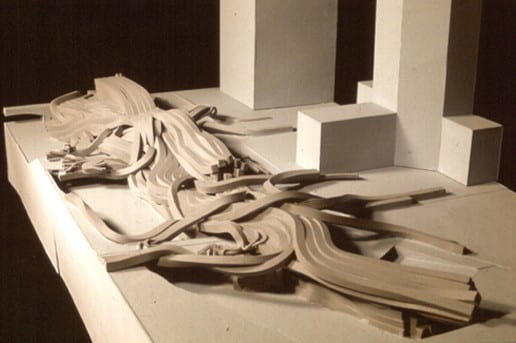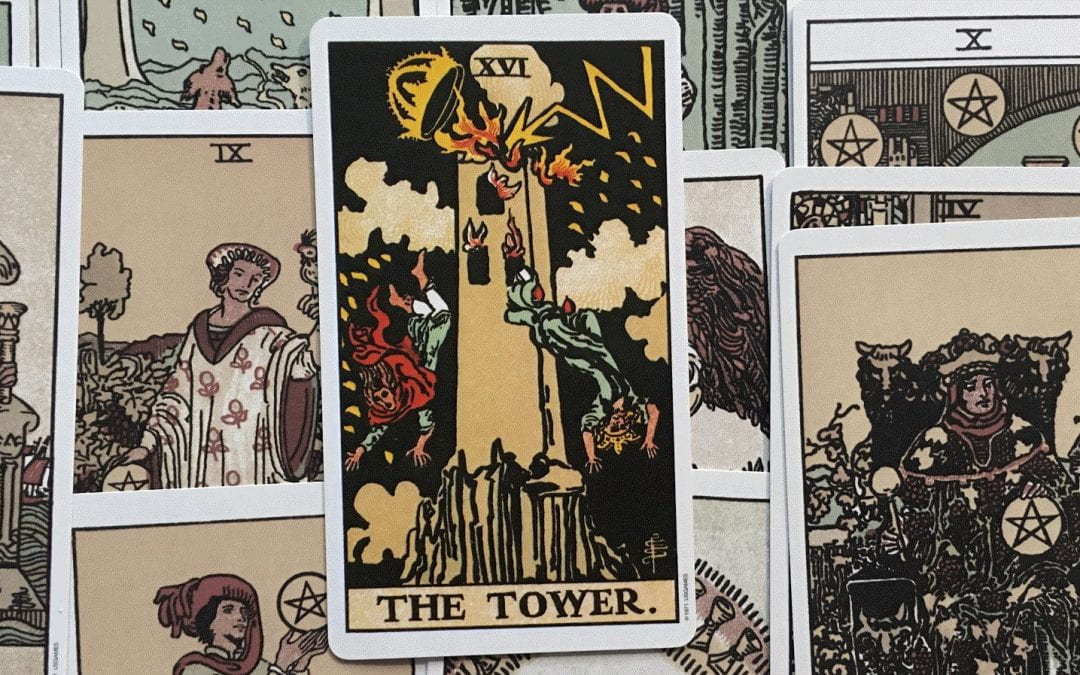“For brief moments flying butterflies were reflected; they seemed to fly through a sky of gravel…(t)he mirror itself is not subject to duration, because it is an ongoing abstraction that is always available and timeless. The reflections, on the other hand, are fleeting instances that evade measure.” – Robert Smithson, Mirror Travels in the Yucatan
The wing of the Airbus is made of glass.
To view a city from the air is to adopt the perspective of a catastrophe, being as it is the vantage of meteors, of terrorists or the Luftwaffe. Or of a flock of birds, flying headlong into the engine.
Between a feature on Louisiana haunted houses and a review for a coffee-table survey of Bond villain lairs, the October 2020 issue of American Airline’s in-flight magazine American Way sported a two-page spread of tarot cards, a composite of different major arcana from various historical sets. Balanced near the fold is XVI, Walter Wegmüller’s version of The Tower from his 1982 Neuzeit Tarot set.
The scene is horrifying. What might be a simple structure in a card from another set is here a creature of leviathan proportions, tongue lolling out of blood-red lips set into the stony body of a brick-work gargoyle. The top of the creature’s head is vanished to reveal the brain of the beast, which swirls in a grey-matter chaos of vaulting skyscrapers and smokestacks. The uppermost portion is aflame. A passenger plane speeds towards the conflagration, watched by a half-lidded eye, about which crackle bolts of lightning.
Were our primary view from the air, we might imagine ourselves not needing to rely on the interesting-facts page of the Sears Tower website to remind us that the most dominant feature of the Chicago skyline is combustible, modeled after bundled cigarettes clutched in the hand of the structural engineer to prove that the Sears Company could vault itself into a sky which now is steadily clouding with ash.
The earliest trans-oceanic aircraft design was the Messerschmitt Me 264, or “New York Bomber,” so named for its intended target of Manhattan. Albert Speer would attest that even into the waning days of the Second World War, Hitler’s ravings would regularly feature gleeful dreams of New York’s vaulting steel-frame skyline being “‘turned into gigantic burning torches, collapsing upon one another…(into) a hurricane of fire.”
The use of steel-skeleton construction in the 10-story Home Insurance Building in Chicago in 1885 inaugurated the age of the skyscraper. With its completion, the differentiating feature of the new age of tall buildings became not just height, but internal structure and its corresponding external expression—in a formal revolution which Michael Holleran terms “the triumph of Chicago functionalism over New York historicism,” the skeleton is made the primary qualifier for a building’s classification as a “skyscraper.” The skyscraper becomes, in morbid estimations of steel frame construction, like a witch at the stake; only revealed in true nature after fire has sloughed its form down to bare bones.
Indeed, flying over them, one has the creeping sensation that these myriad descendants of the Home Insurance Building are saddled with a nature which can only be proven at the precise moment of utter destruction or total transparency. Little wonder that two of the surest ways to accrete glass are to build a skyscraper or to test a nuclear bomb above desert sand.
In a standard tarot deck, The Tower represents danger, crisis, and destruction. Of the major arcana, it is the most straightforwardly negative, associated with sudden unforeseen change. In contrast to the next closest card, Death—which represents the increase of self-awareness from anticipated loss—the tower is rupture unforeseen. The portent of a disaster so unknowable that all one can do it crash like a hapless bird against its skyscraperly bulk.
The American Airlines Route from Los Angeles to Chicago is operated by an Airbus A321. Above the magazine holder, it features an inflight entertainment system equipped with the FlightPath3D flight view software. Rendered in the all-seeing eye of the satellite, the whole of the North American continent is viewable through glass pane.
Scattering across an expanse that voids meaning for a human viewer, the names of cities rise erratically into the lower sky. In the forced perspective of the render, they dither as a skyline-of-skylines, reduced to white text. Though their topographies are invisible, some particularly significant names—Tijuana or New York—come to be emblazoned onto the dull ganzfeld of the computerized sky, as if themselves omens of some future journey or unseen disaster.

Zoom out. The whole plane is now in the field of view, but completely transparent. The names of the cities have changed position. To the sides of the plane and through wings rendered as glass, pixels of grey and green can be seen scrolling listlessly, in liquid combinations of transparency, invisibility, or indistinctness.
Fly in. Chicago’s skyline, glassy and lakeside, makes it the nation’s deadliest for birds. Indeed, for a sparrow, the city must be like the mouth of the underworld itself; a vast and invisible realm which registers its presence only by sudden and fatal interruption of a seemingly forward-proceeding course where migration crashes headlong into a labyrinth of bright lights, and where familiar trees multiply into a grotesque and unreachable infinity; a nowhere-land of death, erupting along primordial flight paths.
Part of the $26 million renovation carrying O’Hare International Airport’s Terminal 5 “well into the future,”—the plan as articulated by Mayor Rahm Emmanuel—was the redesign of the partition separating secured and non-secured areas of the terminal. The result, a bilayered two-story spread of glass panels, depict a birds-eye view of Lake Michigan, the urban surface of Chicagoland, with sprawling suburbs receding into agricultural space. The center of the city saturates for unexplained reasons—there is no legend. The design firm responsible offers the opaque explanation that its inspiration was “NASA satellite imagery of Chicagoland.”
It very well could be a map of the presence of glass, or a loose expression of the geographies of avian lethality which vary block-to-block but average 5,000 dead birds every square-mile in the spring and summer months.
The Terminal 5 partition map is printed on Starphire Ultra-Clear® Glass, a hypertransparent laminated glass which envelops many of the world’s most scintillant new skyscrapers. Its chemical properties engineered to have the effect of making everything laid out before the outward-looking viewer appear bluer. As a result, it is especially popular as a material for ultramodern skyscrapers in areas where poor air quality and high particulate counts have shifted the palette of the sky towards orange. Current trajectories of global fire coverage and industrial smog production seem to portend an increase in demand.
The core conceit of tarot is its utility as a mechanism for contending with supposed supernatural powers actively antagonistic to permanent growth or change. Tarot, for its part, accepts these powers as constitutive of fate. As such, it takes the form of an expository text whose structure is indeterminate and whose features submit themselves to endless rearranging. It is a structure slanted towards infinite transparency, meant to be assembled and reassembled at will, in translation of forces invisible to the petitioner.

Alexander Eisenschmidt and Cheng + Snyder Studio presented Phantom Chicago at the 2013 International Venice Architecture Biennale, a 160-foot wide panorama of designs for various unbuilt Chicago skyscrapers. In the words of Eisenschmidt: “a parallel city, a phantom city, that is not real but does exist in the sense of our architectural consciousness.”
When this parade of excess future was brought to Chicago for an encore exhibition, it was paired with a phone application, Phantom City. The promotional materials show a phone held aloft before a building, the glass surface blueprinting the skyline as an unbuilt design superimposes itself over the built one. Adolf Loos’s Tribune Tower replaces that of Mead Howell and Hood, and the sky changes.
It is cold. A vacant and glassy blue. There are no birds.
Several skyscrapers are presented as cross-sectional diagrams rather than true-life renderings. In these hypertransparent cases, there is no sky to be seen on the other side; the negative space between skeletal frames is bone white.
In tarot, no reading is final. A different arrangement of cards is always possible. In this multiplication, one can intuit a kind of appetite for destruction—a hostility to solidity, to opaqueness. Truth, or perhaps the sensation of it, is found in the gaze of endless, restlessly adjustive rearrangement of forms down to their constituent parts.
One of the many discarded futures in Eisenschmidt’s deck is Greg Lynn’s “Stranded Sears Tower,” a provocative response to Stanley Tigerman’s 1993 call to reshuffle the forms and locations of Chicago landmarks. In Lynn’s vision, the Sears Tower’s cigarettes have burned through their neat bundles as if ignited by a burning sky, the structure collapsing into a mess.
Like the cracked brainpan in Wegmüller’s Tower card, there is something destructive, denuding, violating, lethal about this kind of bared transparency, as if one is playing voyeur in an active surgical theater. Greg Lynn’s Stranded Tower seems to propose this as the price of revelation; the striking-down of the skyscraper “affiliates the structure of the tower with the heterogeneous particularities of its site… laying the structure into its context and entangling its monolithic mass with local contextual forces (which) allows a new monumentality to emerge from old forms.” We are told this reveals something.

It is as if the Sears Tower has been shaken down to earth by some impossible earthquake, the kind anticipated by Frank Lloyd Wright’s National Life Insurance Building—another unbuilt ghost—perhaps the only advertisedly earthquake-proof building in the seismically inactive Midwest.
Tarot, in a way, is a map of glassy futures. A taxonomy of invisible things, and the modes by which we imagine we might negotiate our collisions with them. XIII, Death in the classical interpretation symbolizes the cycle of decay and rebirth. It is not an event foretold. But XVI, The Tower, is an event. The event. The one card which hides more than it reveals, which keeps us drawing cards, building skylines around it, believing that the depiction of the disaster must always precede the destruction.
Interviewed, Eisenschmidt is asked why so many designs in his glass menagerie were never built.
“Maybe some worked better as visionary projects. They were never intended to be literal blueprints.”
The phone application conspires with the transatlantic bomber—enacting some unknowable disaster which tears down one Tribune Building and props up another.
Staring out from blue-tinted windows, toggling the buildings before you, the more concrete portents become harder to see. The sky is not reddening, the birds are not piling up at the foot of the tower, the plane is not headed for disaster.
The deck can always be reshuffled.
The magazine is slipped back, just below a pulsing readout, where only the text, the one-word promise—“Chicago”—is visible. Unable to see the skyline—so small is the screen—we would scarcely know if it had burst entirely into flame.

Sam Clark
Editor
To view a city from the air is to adopt the perspective of a catastrophe, being as it is the vantage of meteors, of terrorists or the Luftwaffe. Or of flock of birds, flying headlong into the engine.
Little wonder that two of the surest ways to accrete glass are to build a skyscraper or to test a nuclear bomb above desert sand.
Tarot is a structure slanted towards infinite transparency, meant to be assembled and reassembled at will, in translation of forces invisible to the petitioner.
Staring out from blue-tinted windows, toggling the buildings before you, the more concrete portents become harder to see. The sky is not reddening, the birds are not piling up at the foot of the tower, the plane is not headed for disaster.
